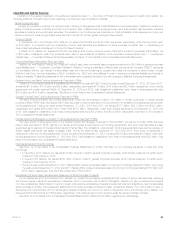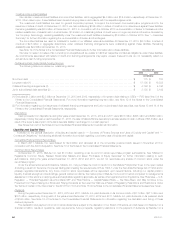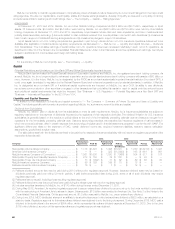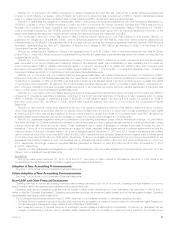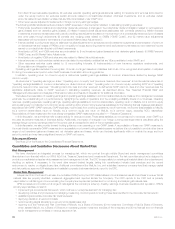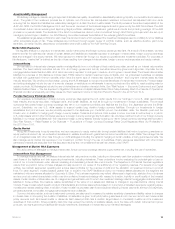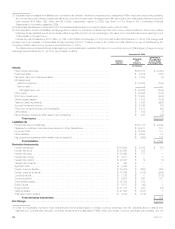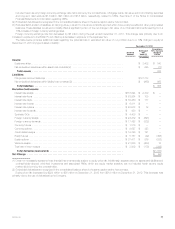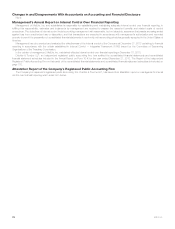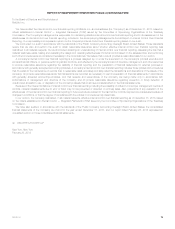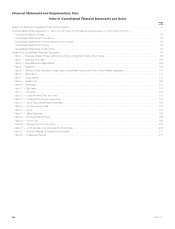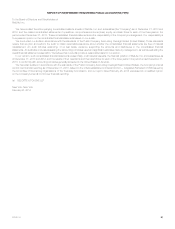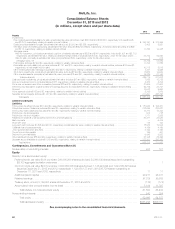MetLife 2013 Annual Report Download - page 81
Download and view the complete annual report
Please find page 81 of the 2013 MetLife annual report below. You can navigate through the pages in the report by either clicking on the pages listed below, or by using the keyword search tool below to find specific information within the annual report.
Asset/Liability Management
We actively manage our assets using an approach that balances quality, diversification, asset/liability matching, liquidity, concentration and investment
return. The goals of the investment process are to optimize, net of income tax, risk-adjusted investment income and risk-adjusted total return while
ensuring that the assets and liabilities are reasonably managed on a cash flow and duration basis. The ALM process is the shared responsibility of the
ALM Unit, GRM, the Portfolio Management Unit, and the senior members of the business segments and is governed by the ALM Committees. The ALM
Committees’ duties include reviewing and approving target portfolios, establishing investment guidelines and limits and providing oversight of the ALM
process on a periodic basis. The directives of the ALM Committees are carried out and monitored through ALM Working Groups which are set up to
manage by product type. In addition, our ALM Steering Committee oversees the activities of the underlying ALM Committees.
We establish target asset portfolios for each major insurance product, which represent the investment strategies used to profitably fund our liabilities
within acceptable levels of risk. These strategies are monitored through regular review of portfolio metrics, such as effective duration, yield curve
sensitivity, convexity, liquidity, asset sector concentration and credit quality by the ALM Working Groups.
Market Risk Exposures
We regularly analyze our exposure to interest rate, equity market price and foreign currency exchange rate risks. As a result of that analysis, we have
determined that the estimated fair values of certain assets and liabilities are materially exposed to changes in interest rates, foreign currency exchange
rates and changes in the equity markets. We have exposure to market risk through our insurance operations and investment activities. For purposes of
this disclosure, “market risk” is defined as the risk of loss resulting from changes in interest rates, foreign currency exchange rates and equity markets.
Interest Rates
Our exposure to interest rate changes results most significantly from our holdings of fixed maturity securities, as well as our interest rate sensitive
liabilities. The fixed maturity securities include U.S. and foreign government bonds, securities issued by government agencies, corporate bonds,
mortgage-backed securities and ABS, all of which are mainly exposed to changes in medium- and long-term interest rates. The interest rate sensitive
liabilities for purposes of this disclosure include debt, PABs related to certain investment type contracts, and net embedded derivatives on variable
annuities with guaranteed minimum benefits which have the same type of interest rate exposure (medium- and long-term interest rates) as fixed
maturity securities. We employ product design, pricing and ALM strategies to reduce the potential effects of interest rate movements. Product design
and pricing strategies include the use of surrender charges or restrictions on withdrawals in some products and the ability to reset crediting rates for
certain products. ALM strategies include the use of derivatives and duration mismatch limits. See “Risk Factors — Economic Environment and Capital
Markets-Related Risks — We Are Exposed to Significant Financial and Capital Markets Risks Which May Adversely Affect Our Results of Operations,
Financial Condition and Liquidity, and May Cause Our Net Investment Income to Vary from Period to Period” in the 2013 Form 10-K.
Foreign Currency Exchange Rates
Our exposure to fluctuations in foreign currency exchange rates against the U.S. dollar results from our holdings in non-U.S. dollar denominated
fixed maturity and equity securities, mortgage loans, and certain liabilities, as well as through our investments in foreign subsidiaries. The principal
currencies that create foreign currency exchange rate risk in our investment portfolios and liabilities are the Euro, the Japanese yen and the British
pound. Selectively, we use U.S. dollar assets to support certain long duration foreign currency liabilities. Through our investments in foreign
subsidiaries and joint ventures, we are primarily exposed to the Japanese yen, the British pound, the Australian dollar, the Mexican peso and the
Korean won. In addition to hedging with foreign currency swaps, forwards and options, local surplus in some countries is held entirely or in part in
U.S. dollar assets which further minimizes exposure to foreign currency exchange rate fluctuation risk. We have matched much of our foreign currency
liabilities in our foreign subsidiaries with their respective foreign currency assets, thereby reducing our risk to foreign currency exchange rate fluctuation.
See “Risk Factors — Risks Related to Our Business — Fluctuations in Foreign Currency Exchange Rates Could Negatively Affect Our Profitability” in
the 2013 Form 10-K.
Equity Market
Along with investments in equity securities, we have exposure to equity market risk through certain liabilities that involve long-term guarantees on
equity performance such as net embedded derivatives on variable annuities with guaranteed minimum benefits and certain PABs. We manage this risk
on an integrated basis with other risks through our ALM strategies including the dynamic hedging of certain variable annuity guarantee benefits. We
also manage equity market risk exposure in our investment portfolio through the use of derivatives. Equity exposures associated with other limited
partnership interests are excluded from this discussion as they are not considered financial instruments under GAAP.
Management of Market Risk Exposures
We use a variety of strategies to manage interest rate, foreign currency exchange rate and equity market risk, including the use of derivatives.
Interest Rate Risk Management
To manage interest rate risk, we analyze interest rate risk using various models, including multi-scenario cash flow projection models that forecast
cash flows of the liabilities and their supporting investments, including derivatives. These projections involve evaluating the potential gain or loss on
most of our in-force business under various increasing and decreasing interest rate environments. The Department of Financial Services regulations
require that we perform some of these analyses annually as part of our review of the sufficiency of our regulatory reserves. For several of our legal
entities, we maintain segmented operating and surplus asset portfolios for the purpose of ALM and the allocation of investment income to product
lines. For each segment, invested assets greater than or equal to the GAAP liabilities and any non-invested assets allocated to the segment are
maintained, with any excess allocated to Corporate & Other. The business segments may reflect differences in legal entity, statutory line of business
and any product market characteristic which may drive a distinct investment strategy with respect to duration, liquidity or credit quality of the invested
assets. Certain smaller entities make use of unsegmented general accounts for which the investment strategy reflects the aggregate characteristicsof
liabilities in those entities. We measure relative sensitivities of the value of our assets and liabilities to changes in key assumptions utilizing internal
models. These models reflect specific product characteristics and include assumptions based on current and anticipated experience regarding lapse,
mortality and interest crediting rates. In addition, these models include asset cash flow projections reflecting interest payments, sinking fund payments,
principal payments, bond calls, mortgage loan prepayments and defaults.
Common industry metrics, such as duration and convexity, are also used to measure the relative sensitivity of assets and liability values to changes
in interest rates. In computing the duration of liabilities, consideration is given to all policyholder guarantees and to how we intend to set indeterminate
policy elements such as interest credits or dividends. Each asset portfolio has a duration target based on the liability duration and the investment
objectives of that portfolio. Where a liability cash flow may exceed the maturity of available assets, as is the case with certain retirement and group
products, we may support such liabilities with equity investments, derivatives or interest rate curve mismatch strategies.
MetLife, Inc. 73


